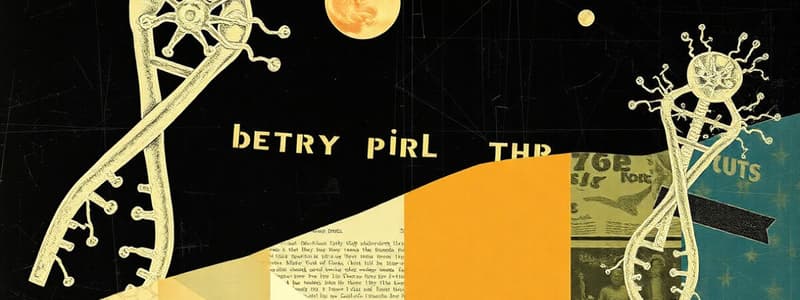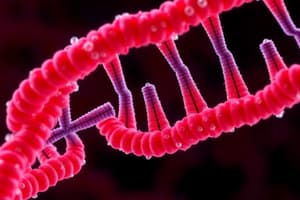Podcast
Questions and Answers
What is the primary function of regulator genes?
What is the primary function of regulator genes?
- To encode proteins that form the structural components of a cell.
- To control the activity of other genes by determining if they are 'on' or 'off'. (correct)
- To transport proteins to their cellular destinations.
- To synthesize the mRNA for structural proteins.
Which type of protein, produced by regulator genes, binds directly to DNA to control gene expression?
Which type of protein, produced by regulator genes, binds directly to DNA to control gene expression?
- DNA binding proteins (correct)
- Enzymes
- Signalling molecules
- Structural proteins
What is the term for genes that produce proteins that become part of the structure and functioning of the organism?
What is the term for genes that produce proteins that become part of the structure and functioning of the organism?
- Structural genes (correct)
- Modifier genes
- Homeotic genes
- Regulator genes
Which of the following best describes the role of homeotic genes?
Which of the following best describes the role of homeotic genes?
Mutations in which type of gene are most likely to result in body parts appearing in unexpected locations?
Mutations in which type of gene are most likely to result in body parts appearing in unexpected locations?
Which of these is NOT a characteristic of gene regulation?
Which of these is NOT a characteristic of gene regulation?
What is the approximate number of genes found in humans?
What is the approximate number of genes found in humans?
Besides acting directly on DNA, how else can regulatory genes control other genes?
Besides acting directly on DNA, how else can regulatory genes control other genes?
What is the primary function of the trp operon?
What is the primary function of the trp operon?
Which of the following components is NOT part of the trp operon structure?
Which of the following components is NOT part of the trp operon structure?
What is the role of the repressor protein in the trp operon?
What is the role of the repressor protein in the trp operon?
When is the trp operon in the 'ON' state?
When is the trp operon in the 'ON' state?
What happens to the repressor protein when tryptophan is present?
What happens to the repressor protein when tryptophan is present?
What is the function of the attenuator region in the trp operon?
What is the function of the attenuator region in the trp operon?
What is a structural gene in the context of the trp operon?
What is a structural gene in the context of the trp operon?
The trp operator region is unique in that it:
The trp operator region is unique in that it:
Why does the trp operon's control mechanism prevent energy waste in E. coli?
Why does the trp operon's control mechanism prevent energy waste in E. coli?
What is the primary role of the promoter (Ptrp) in the trp operon?
What is the primary role of the promoter (Ptrp) in the trp operon?
How does the trp operon regulate the production of proteins?
How does the trp operon regulate the production of proteins?
Which of these is necessary for the repressor protein to become active?
Which of these is necessary for the repressor protein to become active?
The term 'operon' is best described as
The term 'operon' is best described as
The trpL gene is associated with what function within the trp operon?
The trpL gene is associated with what function within the trp operon?
What is the relationship between the level of tryptophan and the activity of the trp operon?
What is the relationship between the level of tryptophan and the activity of the trp operon?
Flashcards
Structural Genes
Structural Genes
Genes that produce proteins which are part of the structure and function of a living organism.
Regulatory Genes
Regulatory Genes
Genes responsible for regulating the activity of other genes. They control if and at what rate other genes are expressed.
DNA Binding Protein
DNA Binding Protein
A regulatory gene whose product is a DNA binding protein that binds to DNA. Functioning in the regulation of gene expression.
Signalling Molecule
Signalling Molecule
Signup and view all the flashcards
Homeotic Genes
Homeotic Genes
Signup and view all the flashcards
Master Control Genes
Master Control Genes
Signup and view all the flashcards
Mutations in homeotic genes
Mutations in homeotic genes
Signup and view all the flashcards
Halteres
Halteres
Signup and view all the flashcards
What is an operon?
What is an operon?
Signup and view all the flashcards
What is the trp operon?
What is the trp operon?
Signup and view all the flashcards
How does the trp operon work?
How does the trp operon work?
Signup and view all the flashcards
What is a regulatory gene?
What is a regulatory gene?
Signup and view all the flashcards
What is a structural gene?
What is a structural gene?
Signup and view all the flashcards
What is repression in gene regulation?
What is repression in gene regulation?
Signup and view all the flashcards
How does tryptophan regulate the trp operon?
How does tryptophan regulate the trp operon?
Signup and view all the flashcards
How does the repressor protein work in the trp operon?
How does the repressor protein work in the trp operon?
Signup and view all the flashcards
What is attenuation in gene regulation?
What is attenuation in gene regulation?
Signup and view all the flashcards
How does the leader region regulate the trp operon?
How does the leader region regulate the trp operon?
Signup and view all the flashcards
Why is attenuation important for the trp operon?
Why is attenuation important for the trp operon?
Signup and view all the flashcards
What is the lac operon?
What is the lac operon?
Signup and view all the flashcards
How does the lac operon respond to lactose?
How does the lac operon respond to lactose?
Signup and view all the flashcards
How does glucose affect the lac operon?
How does glucose affect the lac operon?
Signup and view all the flashcards
How do the lac operon and the trp operon compare?
How do the lac operon and the trp operon compare?
Signup and view all the flashcards
Study Notes
Gene Regulation
- Gene regulation is crucial; genes need to be active at the right time and place, in the right tissues. Different genes have different activation patterns.
- Genes can be classified as structural or regulatory.
- Structural genes produce proteins for structure and function.
- Regulatory genes control other genes, turning them on or off, or adjusting their production rate. These can act as DNA-binding proteins or signalling molecules.
- Homeotic genes are a type of regulatory gene important for embryonic development; mutations can lead to abnormal body part placement.
- A case study highlights how mutations in homeotic genes can alter body structures, such as the development of extra wings or legs in place of antennae.
The trp Operon
- The trp operon is an example of gene regulation in bacteria (E. coli), specifically for tryptophan synthesis.
- The trp operon helps bacteria efficiently synthesize tryptophan when needed.
- The operation is controlled by a group of five structural genes (trpA, trpB, trpC, trpD, and trpE), which make tryptophan synthase, controlled by a promoter (Ptrp), tryptophan operator sequence (Otrp). The operon is regulated in response to tryptophan levels.
- Operon: A group of linked genes with a common promoter and operator region that are transcribed as a single mRNA unit.
- The trp operon is comprised of multiple parts:
- The structural genes coding for the tryptophan synthesis enzymes.
- A regulatory gene encoding a repressor protein.
- A promoter (Ptrp) site where RNA polymerase binds to initiate transcription.
- An operator (Otrp) site where the repressor protein binds to prevent transcription.
- A leader region with the trpL gene (leader peptide) and attenuator that further regulates transcription through attenuation.
- Repression: The trp operon is regulated by repression.
- When tryptophan levels are high, the repressor protein binds to the operator, blocking RNA polymerase. This prevents transcription of the structural genes.
- When tryptophan levels are low, the repressor is inactive and doesn't bind to the operator, allowing RNA polymerase to bind to the promoter and transcribe the structural genes.
- Attenuation: Secondary regulation in the trp operon, also controlled by the leader region.
- The amount of tryptophan present effects the repressor's activity; causing the operon to be turned "ON" or "OFF".
Studying That Suits You
Use AI to generate personalized quizzes and flashcards to suit your learning preferences.




